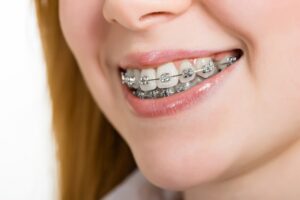10 Effective Ways to Reduce Braces Pain Fast Expert Guide
Braces pain can hit hard, especially during the first few days after getting them or after adjustments. It can make simple things like eating or speaking feel like a challenge. While this discomfort means your orthodontic treatment for teens or adults is working, it doesn’t mean you have to suffer through it without help. There are fast, practical ways to reduce braces pain that actually work. This guide breaks down effective options that bring relief and keep you focused on the end goal—a straighter, healthier smile.
1. Use Orthodontic Wax
Stop Brackets from Rubbing Your Mouth
Brackets sometimes irritate cheeks or lips and create friction, especially during the early treatment phase. Orthodontic wax provides a barrier between braces and the soft tissues inside your mouth.
Take a small piece, roll it into a ball, and press it onto the bracket causing trouble. It helps prevent cuts and gives sore spots time to heal. Reapply as needed, especially after brushing or eating.
2. Rinse with Warm Salt Water
Soothe Sore Gums Naturally
Warm salt water rinsing. reduces inflammation and promotes healing. It’s a quick fix that works without medication. Mix half a teaspoon of salt with a glass of warm water. Swish it around your mouth for 30 seconds, then spit it out.
Repeat this rinse two to three times a day when discomfort hits. It helps reduce swelling and keeps your mouth clean.
3. Apply a Cold Compress
Numb the Pain
Cold temperatures help reduce inflammation and numb nerve endings. Use an ice pack wrapped in a towel and press it gently against your cheek. Keep it there for 10 to 15 minutes at a time.
You can also suck on an ice cube if you prefer direct relief. Just don’t chew the ice, as that can damage your braces.
4. Take Over-the-Counter Pain Relievers
Get Fast Relief for Severe Soreness
Ibuprofen or acetaminophen helps control moderate to strong pain after adjustments. Take it before your appointment if you know it usually causes discomfort. Follow the dosage instructions and don’t rely on medicine every time.
Pain relievers work best during the first 24 to 48 hours after your braces are tightened.
5. Eat Soft, Cold Foods
Choose Foods That Feel Good
Avoid hard and chewy meals when your mouth feels sore. Stick to soft and cold foods that won’t put extra pressure on your teeth.
Go for:
-
Yogurt
-
Mashed potatoes
-
Applesauce
-
Smoothies
-
Soft-cooked pasta
Cold foods can also reduce swelling while helping you stay nourished.
6. Use a Silicone Mouth Guard at Night
Avoid Grinding and Extra Pressure
Teeth grinding during sleep can increase soreness. If you wake up with jaw pain, a silicone mouth guard might help. It cushions your teeth and protects your braces overnight.
This is especially helpful for those undergoing TMJ/TMD treatment in Landstuhl, as it can prevent nighttime clenching that aggravates jaw joints.
Talk to your orthodontist if grinding becomes a habit. They may recommend a guard that fits better or suggest other ways to ease pressure.
7. Massage Your Gums
Improve Blood Flow and Relax Your Mouth
Gentle gum massages reduce tension and increase circulation. Use a clean finger or soft-bristled toothbrush and rub your gums in small circles. Focus on the sore areas but avoid too much pressure.
This method works best after a warm rinse or brushing your teeth. It eases tension in your jaw and promotes healing.
8. Avoid Crunchy and Sticky Foods
Prevent More Pain and Damage
Hard and sticky snacks not only risk damaging your braces but also increase soreness during chewing. Foods like chips, caramel, or hard bread force your teeth to work harder. That leads to more pressure on already sensitive areas.
Stick to gentle meals and cut your food into small bites to limit discomfort while chewing.
9. Stay Hydrated Throughout the Day
Keep Your Mouth Healthy and Pain Levels Lower
Dry mouth increases friction, making your braces feel more uncomfortable. Drinking water keeps your mouth moist, helps with digestion, and reduces the chance of gum irritation.
Sip water frequently, especially during meals or after talking for long periods. Hydration also keeps food particles from sticking around your brackets.
10. Keep a Consistent Oral Hygiene Routine
Clean Braces Reduce Irritation
Trapped food can cause swollen gums and sore spots. If your teeth feel dirty or your mouth smells, your discomfort may increase. Brushing and flossing regularly help keep pain levels down.
Use a soft toothbrush and brush slowly. Clean around your wires and brackets, then rinse thoroughly. Consider using a water flosser if traditional flossing feels tough.
Bonus: Rest and Give It Time
Pain often lessens after the first few days. Your teeth, gums, and cheeks begin to adjust. Give your body a chance to settle before assuming something’s wrong. If pain continues beyond a week or becomes worse, contact your orthodontist to check your braces.
Why Braces Cause Pain in the First Place
It helps to understand why braces hurt. The pressure applied by wires shifts your teeth into place. This pressure stretches and compresses the bone around your roots, which leads to soreness. Your body responds by remodeling the bone to move your teeth.
This process works slowly and creates natural inflammation. It’s a sign that treatment is progressing. Still, you can take steps to stay comfortable while your teeth shift into alignment.
When to Call the Orthodontist
Pain that lasts more than five days or increases sharply may point to a problem. Broken wires, loose brackets, or poking hardware could be the cause. Don’t wait too long to ask for help. Ignoring the issue could delay your treatment or lead to more pain.
If you notice any of the following, reach out right away:
-
Sores that won’t heal
-
Sharp pain that worsens daily
-
Bleeding that doesn’t stop
-
Broken or bent wires
Your orthodontist may adjust your braces or provide tools to make things easier.
Meet Dr. Michael Dillon, a trusted orthodontic specialist in Landstuhl, who provides expert care and support throughout your treatment. He can adjust your braces or recommend personalized solutions to help you feel better fast.
Staying Positive During Treatment
Dealing with pain can feel discouraging, especially in the early months of wearing braces. But each step brings you closer to your goal. Staying positive and practicing good habits can make the process feel smoother.
Remember, most people experience soreness after adjustments, but the discomfort usually fades within a few days. Use that time to focus on soft foods, home remedies, and rest. You’ll build a routine that makes each adjustment easier to manage.
Final Thoughts
Braces pain doesn’t have to slow you down. You can manage it with simple home techniques that give fast relief. Focus on comfort, good hygiene, and proper eating habits to support your progress. A little preparation goes a long way when it comes to handling braces discomfort.
Contact us today to learn more about how we can make your orthodontic journey smoother and more comfortable. With the right care and guidance, a straight, healthy smile is closer than you think.
Keep these strategies in mind before your next appointment or adjustment. They’ll help you get through the toughest days and stay on track for a straight, healthy smile.






 Dillon Orthodontic Care
Dillon Orthodontic Care